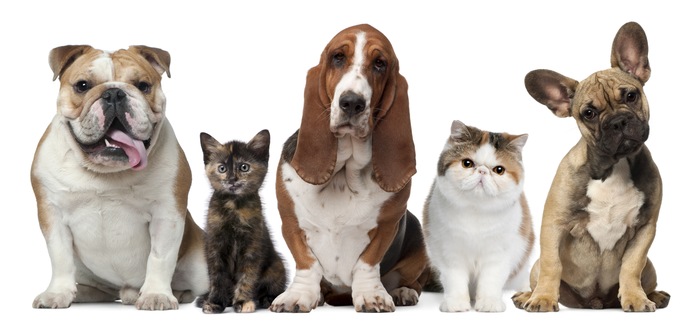If you are reading this, chances are you share your life with a dog or cat, yet do you really know about your pet? Here are some fun, little known facts about dogs and cats.
- Dogs can see in color, though they most likely see colors like a color-blind human (shades of grey and do not see blues and reds). They can see better in low light.
- Cats are lactose intolerant. Like most mammals, cats lose the ability to digest dairy after infancy. Feeding milk to a cat can encourage stomach upset and diarrhea so even though you think a cat would like a nice bowl of milk, this would be a bad idea.
- Dogs with squashed faces have more health problems. The structure of the faces of Pugs, Boxers, and Bulldogs makes them more prone to respiratory problems, dental problems, and other health issues.
- Dog and cat noses have unique ridged patterns similar to that of human fingerprints.
- The human heart beats 60-80 beats per minutes. A cat's heart beats twice as fast. A new born kitten heartbeat is 220 – 260 beats per minute.
- It takes eighteen muscles to move a dog’s ear. This specificity of motion helps the dog pinpoint the origins of sounds much faster than a human can. A dog can locate the source of a sound in 1/600 of a second and can hear sounds four times farther away than a human can.
- A single pair of cats and their kittens can produce as many as 420,000 kittens in just 7 years. A perfect reason to ensure your cat is spayed/neutered. For feral or wild cats, there are TNR (trap, neuter, return) programs to decrease the population growth.
- The average dog can run about 19 mph. Greyhounds are the fastest dog and can run at speeds of 45 mph. A Cheetah can run as fast as 75 mph for short spurts.
- Cats spend 16-20 hours of each day sleeping. With that in mind, a seven-year old cat has only been awake for two years of its life.
- Cats spend 30% of their waking hours grooming themselves. They are only awake 6-8 hours a day, if that, so 30% would be about 2 hours, leaving around 4 hours. They eat, do their business, chase the dog, and watch squirrels for 3 hours. This leaves them 1 hour to spend with you, their owner.
- Dogs with long floppy ears are more prone to ear infections. Cocker Spaniels, Pugs, and Shar Pei’s can development what is called Otitis Externa. This is an ear infection that leads to the ear canal swelling shut creating a very painful ailment for the dog.
- All kittens are born with blue eyes. They begin to change color about two weeks after their eyes open.
- A dog’s sense of smell is up to one hundred thousand times more sensitive than a human’s. While humans have about five million scent receptors in their noses, a bloodhound has up to three hundred million. A ferret’s sense of smell is like a dog smelling a fly two-miles away.
- When cats walk, their left front leg moves in tandem with their left back leg, and their right legs do the same. The only other animals that walk this way are giraffes and camels.
- Dogs’ wet noses help them smell better. The mucus attracts and catches more chemical scent particles in the air.
- Cats don’t meow at other cats. They reserve this sound for getting attention (not to mention food) from humans. This is not to say that cats do not talk to other cats or in some cases scream if they are fighting.
- Dogs are about as smart as a two- or three-year-old child. They can understand about 150-200 words, including signals and hand movements with the same meaning as words. The Border Collie has been touted as the most intelligent dog breed with Golden Retrievers and German Shepherds coming in second and third.
- The proper name for a group of cats is a clowder. A group of kittens is called a kindle.
- Dogs’ only sweat glands are between the pads of their feet. They dissipate the majority of their heat by panting, a method far more effective than allowing moisture to evaporate from the skin. If your dog is panting excessively and their gums and tongue are pale, both signs of heat exhaustion, remove them from the heat and into a cool house of vehicle with A/C running.
- Your dog or cat can read your moods. If you're sad or under stress, you may also notice a difference in your dog or cat's behavior. If you are driving with your dog and you are suddenly cut off and vocalize to the other driver where to go, your dog will think you are yelling at them. The same applies when watching sports. If you yell when Tiger misses a putt, your dog will react as if you are yelling at them. Some dogs will become agitated and have anxiety as soon as a televised sporting event comes on.
Knowing more about your pet helps you better read their behavior and act appropriately. A dog pacing and shaking for no apparent reason is usually the sign of a fast approaching thunderstorm. Dogs can feel the barometric pressure changes and thus are very aware of oncoming inclement weather. Fascinating stuff.
Remember, Adopt, Don’t Shop.

